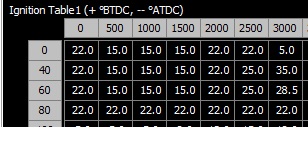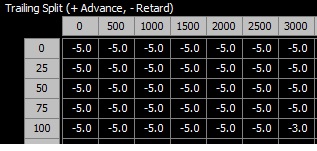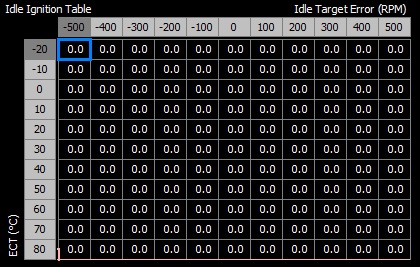Base timing for idle?
#1
Base timing for idle?
Looking for info on what ideal timing should be set to for idle with a single Turbo conversion, after searching across the web having a hard time locating the info to verify this with the basemap provided by Link.
Here's some screen shots of the current Ignition timing / Split.

Split:

Any info would be greatly appreciated.
Here's some screen shots of the current Ignition timing / Split.

Split:

Any info would be greatly appreciated.
#3
Eye In The Sky
iTrader: (2)
Join Date: Feb 2001
Location: In A Disfunctional World
Posts: 7,893
Likes: 0
Received 114 Likes
on
66 Posts
The stock timing was very retarded to cause the exhaust to run hot for the cats.
This required a lot of air flow and fuel to maintain the idle, but it was smooth and rich.
What ever gives the smoothest leanest idle is the answer unless you are worried about emissions.
It will vary between no load and light load like running the Ac.
Mine likes 12 IGL WITH 29 IGT.
With a PFC using the idle control, it ignores what you enter for idle timing. This then requires you to go to a pure manual idle control by putting in 0 for all three idle speeds.
This required a lot of air flow and fuel to maintain the idle, but it was smooth and rich.
What ever gives the smoothest leanest idle is the answer unless you are worried about emissions.
It will vary between no load and light load like running the Ac.
Mine likes 12 IGL WITH 29 IGT.
With a PFC using the idle control, it ignores what you enter for idle timing. This then requires you to go to a pure manual idle control by putting in 0 for all three idle speeds.
#4
The stock timing was very retarded to cause the exhaust to run hot for the cats.
This required a lot of air flow and fuel to maintain the idle, but it was smooth and rich.
What ever gives the smoothest leanest idle is the answer unless you are worried about emissions.
It will vary between no load and light load like running the Ac.
Mine likes 12 IGL WITH 29 IGT.
With a PFC using the idle control, it ignores what you enter for idle timing. This then requires you to go to a pure manual idle control by putting in 0 for all three idle speeds.
This required a lot of air flow and fuel to maintain the idle, but it was smooth and rich.
What ever gives the smoothest leanest idle is the answer unless you are worried about emissions.
It will vary between no load and light load like running the Ac.
Mine likes 12 IGL WITH 29 IGT.
With a PFC using the idle control, it ignores what you enter for idle timing. This then requires you to go to a pure manual idle control by putting in 0 for all three idle speeds.
#5
Moderator
iTrader: (3)
Join Date: Mar 2001
Location: https://www2.mazda.com/en/100th/
Posts: 30,816
Received 2,587 Likes
on
1,838 Posts
@1500rpm, you should be able to run mixtures in the mid 14's...
#7
Short answer: easiest thing to do is just have a high base idle and it doesn't matter much. Smoothest idle is retarded base timing w/ lots of baseline air and many compensation settings, but requires lots of tuning and engine management with a lot of settings.
Detailed answer: The PFC is kind of in its own category because it has limited adjustability in the software for all the various idle parameters. You're using a Link, so you have more options. Now if you just want a 1100rpm idle or whatever you can drive around like that and it will vary a lot according to engine condition, but it's the simplest solution. That's what a lot of people do; they don't want to put forth the effort setting up all the aspects of idle (throttlebody adjustment, ISC duty, timing). Now basic rules of thumb for idle timing:
more timing advance = more torque, less stable combustion (rougher idle), lower specific fuel consumption, worse emissions
less timing advance = less torque (requiring more air), slightly worse specific fuel consumption, more stable combustion (smoother idle), lower emissions
Most stable combustion is from retarded timing, with rich mixture or airpump pumping into exhaust ports like stock
So it comes down to the goal if the tuning. IF you have no idle air compensation at all (no thermowax/mechanical fast idle valve, no idle speed control solenoid valve) you probably want to increase engine torque to prevent stall. Therefore more timing advance is preferable. IF you want the smoother idle and have good software control over idle compensation, you want to run something closer to stock. So basically, retarded timing with wide split, then use idle air duty cycle and spark timing to compensate for loads. Now allow me to get [more] technical for a second.
Torque Requirements & Torque Reserve
When Torque created by engine = torque requirements on engine (friction, accessories, etc), engine speed stays about the same. When loads on the engine increase, engine speed drops and the engine could stall. To compensate, we can use ignition timing (fast increase in torque) or air (slow increase in torque).
We can set our ignition timing to create a "torque reserve." When we run more retarded base ignition timing, the ECU can quickly advance the timing to use this "torque reserve" to smooth out the idle. Look at a modern engine in a warm idle condition. You'll see that if you turn on an accessory, often the ignition timing will quickly advance for a second (using the torque reserve) to prevent a significant drop in idle. Then the timing will retard and the electronic throttle will add air. Manifold vacuum will probably decrease.
Now if our baseline ignition timing has significant advance (something like 20 degrees), we have basically 0 torque reserve. If accessory loads kick on, and we use timing compensation to advance timing even more, it doesn't help so much. Combustion gets less stable, and in some cases you could get more surging. That's why on stock configurations, engines have more retarded timing than necessary.
Detailed answer: The PFC is kind of in its own category because it has limited adjustability in the software for all the various idle parameters. You're using a Link, so you have more options. Now if you just want a 1100rpm idle or whatever you can drive around like that and it will vary a lot according to engine condition, but it's the simplest solution. That's what a lot of people do; they don't want to put forth the effort setting up all the aspects of idle (throttlebody adjustment, ISC duty, timing). Now basic rules of thumb for idle timing:
more timing advance = more torque, less stable combustion (rougher idle), lower specific fuel consumption, worse emissions
less timing advance = less torque (requiring more air), slightly worse specific fuel consumption, more stable combustion (smoother idle), lower emissions
Most stable combustion is from retarded timing, with rich mixture or airpump pumping into exhaust ports like stock
So it comes down to the goal if the tuning. IF you have no idle air compensation at all (no thermowax/mechanical fast idle valve, no idle speed control solenoid valve) you probably want to increase engine torque to prevent stall. Therefore more timing advance is preferable. IF you want the smoother idle and have good software control over idle compensation, you want to run something closer to stock. So basically, retarded timing with wide split, then use idle air duty cycle and spark timing to compensate for loads. Now allow me to get [more] technical for a second.
Torque Requirements & Torque Reserve
When Torque created by engine = torque requirements on engine (friction, accessories, etc), engine speed stays about the same. When loads on the engine increase, engine speed drops and the engine could stall. To compensate, we can use ignition timing (fast increase in torque) or air (slow increase in torque).
We can set our ignition timing to create a "torque reserve." When we run more retarded base ignition timing, the ECU can quickly advance the timing to use this "torque reserve" to smooth out the idle. Look at a modern engine in a warm idle condition. You'll see that if you turn on an accessory, often the ignition timing will quickly advance for a second (using the torque reserve) to prevent a significant drop in idle. Then the timing will retard and the electronic throttle will add air. Manifold vacuum will probably decrease.
Now if our baseline ignition timing has significant advance (something like 20 degrees), we have basically 0 torque reserve. If accessory loads kick on, and we use timing compensation to advance timing even more, it doesn't help so much. Combustion gets less stable, and in some cases you could get more surging. That's why on stock configurations, engines have more retarded timing than necessary.
Trending Topics
#8
Moderator
iTrader: (3)
Join Date: Mar 2001
Location: https://www2.mazda.com/en/100th/
Posts: 30,816
Received 2,587 Likes
on
1,838 Posts
here is the idle timing graph from the S5 cars.
#9
Even more great information 
I have the options to make adjustments to both air control and timing specifically for idle. I did retain the IAC for this project so I can adjust the duty cycle of the IAC for idle:

I also have the option of a closed loop idle control via timing:

One of the very few things the Link can't currently do is an overlay / adjustment for the trailing split (I did submit a request at the Link forums under the "Wishlist" area of their forums for this, as well as a request for an option be added on the dual fuel table for "E85/Ethanol" to add a little bit more definition for the Flexfuel setup I'm going to be running).
I did play around with the Fuel table and got the AFR's in the mid 14's at 1400 rpm without adjusting the Link timing basemap (15 BTDC w/ -5 Split). After seeing the response's posted it gives me a good range to play around with that I feel comfortable with trying (anything in between -5 to 20). My current plan of attack is to get it warmed up, unplug the IAC, and start adjusting the timing until I get it a few hundred rpm below my target (basically have it fighting to stay running) and then reconnect the IAC and adjust the IAC duty cycle to get it up to the target RPM. Now the question of the day is knowing this engine is going to Flex Fuel (93/E85), which is the better option for primary Idle control (IAC or timing)?
I have the options to make adjustments to both air control and timing specifically for idle. I did retain the IAC for this project so I can adjust the duty cycle of the IAC for idle:

I also have the option of a closed loop idle control via timing:

One of the very few things the Link can't currently do is an overlay / adjustment for the trailing split (I did submit a request at the Link forums under the "Wishlist" area of their forums for this, as well as a request for an option be added on the dual fuel table for "E85/Ethanol" to add a little bit more definition for the Flexfuel setup I'm going to be running).
I did play around with the Fuel table and got the AFR's in the mid 14's at 1400 rpm without adjusting the Link timing basemap (15 BTDC w/ -5 Split). After seeing the response's posted it gives me a good range to play around with that I feel comfortable with trying (anything in between -5 to 20). My current plan of attack is to get it warmed up, unplug the IAC, and start adjusting the timing until I get it a few hundred rpm below my target (basically have it fighting to stay running) and then reconnect the IAC and adjust the IAC duty cycle to get it up to the target RPM. Now the question of the day is knowing this engine is going to Flex Fuel (93/E85), which is the better option for primary Idle control (IAC or timing)?
#10
Moderator
iTrader: (3)
Join Date: Mar 2001
Location: https://www2.mazda.com/en/100th/
Posts: 30,816
Received 2,587 Likes
on
1,838 Posts
i would start by setting the timing flat, and then adjust the IAC to get your target speed, and then start playing with timing and see how its acts.
#11
What makes this complicated is that it is a mechanical throttlebody, with throttle plate adjustment screws, air bleed screw, a mechanical fast idle valve, a mechanical dashpot, and an ISC solenoid. There are literally a lot of moving parts.
You have the basic idea right, of setting the idle below target with the air bleed screw. Then add in IAC duty cycle. Usually you want ISC duty cycle to be around 40-60% at a baseline condition, so that it has room to move up and down. With that in mind, I downloaded the Link software from their website so I could help you better. If you look at their "Open loop ISC control" procedure, that will help you get started. My advice to you is this: try adjusting your throttlebody air screw such that you can achieve your target warm idle at a duty cycle of about 40% . This gives your feedback system room to add or subtract duty cycle.
I looked at the ignition control. One thing I like about this Link software is that it gives you a lot of flexibility to define the x axis of the table. It seems like the way they have the software set up, the ignition timing control would be prone to fighting the ISC idle control if they were activated together. So if you do it, only have the ignition timing kick in as a sort of additional anti-stall. Basically, the ISC airflow-based idle control portion is much more adjustable than the ignition timing compensation for idle. For that reason I personally would only use only ISC, not ignition timing feedback. You'll have to do real-world testing to confirm.
See what the engine will tolerate as far as base ignition timing. You might find the engine runs smoother with more retarded timing, but as I pointed out you will need more air. Once you set your idle using the procedure I mentioned above, try doing an ignition timing sweep in 2 degree increments. See how that affects idle stability in the warm idle condition.
You have the basic idea right, of setting the idle below target with the air bleed screw. Then add in IAC duty cycle. Usually you want ISC duty cycle to be around 40-60% at a baseline condition, so that it has room to move up and down. With that in mind, I downloaded the Link software from their website so I could help you better. If you look at their "Open loop ISC control" procedure, that will help you get started. My advice to you is this: try adjusting your throttlebody air screw such that you can achieve your target warm idle at a duty cycle of about 40% . This gives your feedback system room to add or subtract duty cycle.
I looked at the ignition control. One thing I like about this Link software is that it gives you a lot of flexibility to define the x axis of the table. It seems like the way they have the software set up, the ignition timing control would be prone to fighting the ISC idle control if they were activated together. So if you do it, only have the ignition timing kick in as a sort of additional anti-stall. Basically, the ISC airflow-based idle control portion is much more adjustable than the ignition timing compensation for idle. For that reason I personally would only use only ISC, not ignition timing feedback. You'll have to do real-world testing to confirm.
See what the engine will tolerate as far as base ignition timing. You might find the engine runs smoother with more retarded timing, but as I pointed out you will need more air. Once you set your idle using the procedure I mentioned above, try doing an ignition timing sweep in 2 degree increments. See how that affects idle stability in the warm idle condition.
#12
Moderator
iTrader: (3)
Join Date: Mar 2001
Location: https://www2.mazda.com/en/100th/
Posts: 30,816
Received 2,587 Likes
on
1,838 Posts
The following users liked this post:
a.tapos (05-14-20)
Thread
Thread Starter
Forum
Replies
Last Post
trickster
2nd Generation Specific (1986-1992)
25
07-01-23 04:40 PM
stickmantijuana
Engine Management Forum
11
11-09-15 01:15 PM
ncds_fc
New Member RX-7 Technical
1
08-15-15 10:06 AM


